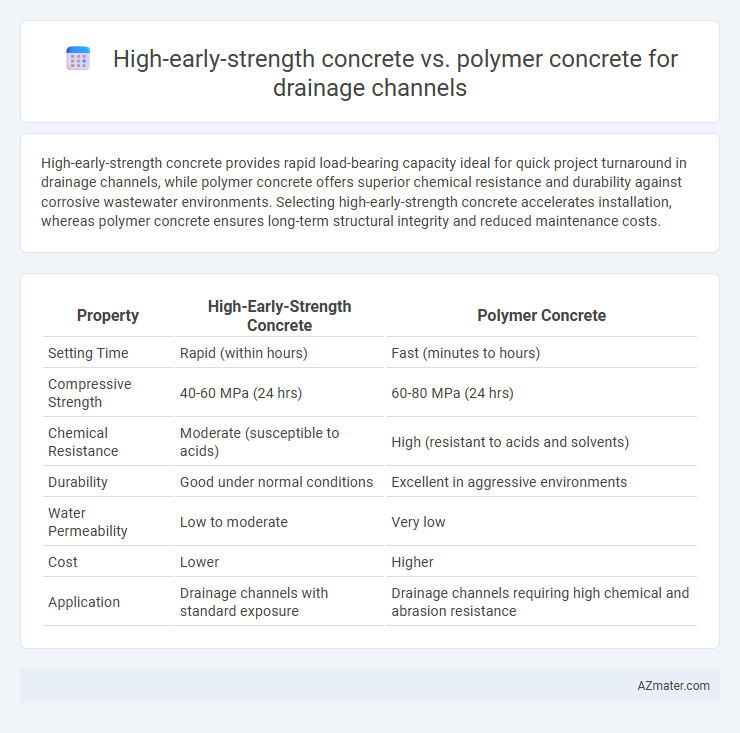High-early-strength concrete provides rapid load-bearing capacity ideal for quick project turnaround in drainage channels, while polymer concrete offers superior chemical resistance and durability against corrosive wastewater environments. Selecting high-early-strength concrete accelerates installation, whereas polymer concrete ensures long-term structural integrity and reduced maintenance costs.
Table of Comparison
| Property | High-Early-Strength Concrete | Polymer Concrete |
|---|---|---|
| Setting Time | Rapid (within hours) | Fast (minutes to hours) |
| Compressive Strength | 40-60 MPa (24 hrs) | 60-80 MPa (24 hrs) |
| Chemical Resistance | Moderate (susceptible to acids) | High (resistant to acids and solvents) |
| Durability | Good under normal conditions | Excellent in aggressive environments |
| Water Permeability | Low to moderate | Very low |
| Cost | Lower | Higher |
| Application | Drainage channels with standard exposure | Drainage channels requiring high chemical and abrasion resistance |
Introduction to Drainage Channel Materials
High-early-strength concrete offers rapid strength gain, allowing quicker construction and early load application in drainage channels, making it ideal for time-sensitive projects. Polymer concrete, composed of resin binders and aggregates, provides superior chemical resistance and durability against aggressive wastewater environments found in drainage systems. Selecting between these materials depends on project requirements for strength development speed and long-term chemical exposure resilience.
Overview of High-Early-Strength Concrete
High-early-strength concrete achieves rapid strength gain within 24 hours, making it ideal for drainage channels requiring quick turnaround and early load-bearing capacity. This concrete type typically incorporates high C3S (tricalcium silicate) content and accelerators like calcium chloride to expedite hydration and strength development. Its fast-setting characteristics enable early form removal and minimize construction downtime, ensuring efficient project timelines for drainage infrastructure.
Overview of Polymer Concrete
Polymer concrete, composed of a polymer binder combined with aggregates, offers superior chemical resistance and durability compared to traditional high-early-strength concrete, making it ideal for drainage channels exposed to aggressive environments. Its rapid curing properties ensure quick installation and minimal downtime, while the enhanced tensile strength reduces cracking and maintenance needs. This material's resistance to water, acids, and alkalis significantly extends the lifespan of drainage infrastructure in industrial and urban applications.
Comparative Composition and Chemical Properties
High-early-strength concrete for drainage channels typically contains high cement content and specialized admixtures like calcium chloride to accelerate hydration and achieve rapid strength gain within 24 hours, optimizing durability and chemical resistance against sulfates and chlorides. Polymer concrete incorporates resin binders such as epoxy or polyester, replacing traditional cement, which enhances its chemical inertness, superior resistance to acids, alkalis, and aggressive compounds commonly found in drainage environments. The chemical properties of high-early-strength concrete rely on rapid cement hydration and calcium silicate hydrate formation, while polymer concrete's resistance comes from cross-linked polymer matrices that offer better impermeability and reduced porosity, making polymer concrete more effective in harsh chemical exposures.
Mechanical Strength and Load-Bearing Capacity
High-early-strength concrete exhibits superior compressive strength within the first 24 hours, reaching up to 30 MPa, which enhances the load-bearing capacity of drainage channels under heavy traffic conditions. Polymer concrete offers enhanced tensile strength and chemical resistance, with flexural strengths around 15 MPa, making it suitable for aggressive environmental exposure but typically lower in early compressive strength than high-early-strength concrete. Mechanical strength in high-early-strength concrete provides rapid formwork removal and early service, whereas polymer concrete ensures durability and flexibility against cracking, improving long-term structural performance in drainage systems.
Durability in Aggressive Drainage Environments
High-early-strength concrete offers rapid gain in compressive strength, making it suitable for fast-track drainage channel construction but may face durability challenges in aggressive environments with high chemical exposure. Polymer concrete, composed of resin binders and aggregates, exhibits superior chemical resistance and reduced permeability, enhancing long-term durability in harsh drainage conditions with acidic or saline wastewater. For drainage channels exposed to aggressive agents, polymer concrete outperforms high-early-strength concrete by maintaining structural integrity and minimizing degradation over extended service life.
Installation Process and Curing Time
High-early-strength concrete offers a rapid installation process with initial set times as short as 4 to 6 hours, allowing drainage channels to be operational within 24 hours due to its accelerated curing. Polymer concrete requires longer curing times, typically 24 to 48 hours, because it relies on polymerization rather than hydration, which can delay the installation timeline despite superior chemical resistance. The difference in curing mechanisms significantly impacts project scheduling, making high-early-strength concrete more suitable for projects demanding quick turnaround, while polymer concrete is preferred for durability in chemically aggressive environments.
Cost Considerations and Life Cycle Analysis
High-early-strength concrete offers lower initial material costs and faster curing times, reducing labor expenses for drainage channel installation, whereas polymer concrete has higher upfront costs due to specialized resins and additives. Life cycle analysis reveals polymer concrete's superior resistance to chemical corrosion, abrasion, and environmental degradation, resulting in extended service life and less frequent maintenance compared to high-early-strength concrete. Evaluating total ownership costs, polymer concrete may provide better long-term economic benefits despite higher initial investment, especially in aggressive or corrosive drainage environments.
Environmental Impacts and Sustainability
High-early-strength concrete for drainage channels offers rapid setting and early load-bearing capacity but typically involves higher cement content, leading to increased carbon emissions and energy consumption during production. Polymer concrete, composed of resin binders and aggregates, reduces reliance on Portland cement, lowering greenhouse gas emissions and enhancing chemical resistance, thereby potentially extending the service life of drainage infrastructure and reducing maintenance frequency. Assessing life cycle environmental impacts, polymer concrete often provides improved sustainability through reduced resource extraction and waste generation compared to traditional high-early-strength concrete formulations.
Application Suitability: Choosing the Right Material
High-early-strength concrete is ideal for drainage channels requiring rapid strength development, enabling quick installation and early load-bearing capacity. Polymer concrete offers superior chemical resistance and durability against harsh environmental conditions, making it suitable for aggressive or corrosive drainage environments. Selecting between these materials depends on project timelines and exposure factors, with high-early-strength concrete favored for fast construction and polymer concrete chosen for long-term resilience.

Infographic: High-early-strength concrete vs Polymer concrete for Drainage channel
 azmater.com
azmater.com